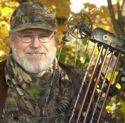What’s the ideal pre-season warmup for archery deer season?
It might be a combination of target practice, and shooting fish. Bow fishing is a good way to sharpen up archery skills, while removing undesirable fish species in the process.
Bow fishing is legal year-round in Kentucky, but only rough fish species may be taken. There is no limit on most rough fish species, but alligator gar and lake sturgeon may not be taken because restoration programs are underway for the two species.

Catfish have a daily creel limit of five and paddlefish have a daily creel limit of two.
Species most frequently taken by bow fishermen include: catfish, common carp, grass carp, freshwater drum, longnose gar, buffalo and suckers. In the Mississippi, Ohio, Green and Kentucky River, and Lake Barkley and Kentucky Lake, the number one target species is Asian carp.
Silver and bighead carp, non-native species, have become established in rivers and lakes of the Midwest and pose a threat to native game fish species. They feed on plankton but grow to enormous size.
It’s not uncommon for bow fishermen in Kentucky waters to take silver carp in the 15- to 20-pound range and bighead carp in the 40 to 50-pound range.
Records and Regulations
Each year archers arrow big fish in Kentucky waters. What’s amazing is that Kentucky’s bow fishing records sometimes exceed hook-and-line state records. Take a look at Kentucky’s 28 state bow fishing records at this link.
Bow fisherman may shoot fish within 200 yards of a dam, but not from a boat in waters where boats are restricted. Some waters in Kentucky are off limits to bow fishing. For complete bow fishing regulations visit this website. Scroll down to the section on fishing methods.
To shoot fish, archers must have a fishing license.
Ideal Water Conditions
Most bow fishing is done at night, with archers shooting from elevated platforms on john boats, using generators and halogen lights to illuminate the fish suspended just below the surface.

But archers can find plenty of action during daylight hours, too, wading small streams, walking the banks of a small lake or wetland, or shooting from a boat below dams or in backwater areas of major rivers.
Bow fishing is at its best in the spring and summer when rough fish are spawning and typically in shallower water, or actively feeding post-spawn, in warm, fertile waters.
Rising water levels create good opportunities because fish move up to the banks.
As spring progresses into summer, carp and other bottom feeding fish, move out into deeper water on grassy flats in rivers and lakes.
It’s best to check the water levels and go when water conditions are ideal. Clear and stable water conditions are always best. A falling water level pulls fish off the banks into deeper water, where they are harder to see. Stained water conditions, caused by heavy rains, can make it more difficult to see fish and judge their depth.
Gear
Just about any type of bow can be used for bow fishing as long as a reel can be mounted on the bow’s riser.
Bow fishing reels are heavy duty, with a good drag, and spooled in heavy braided line that is tied to the arrow through a hole near the arrow’s nock. A fish that is “stuck” is reeled it, but with a big fish that can take several minutes.
Recurve bows are a good option because they are light and it doesn’t take much poundage to spear a fish with a fishing arrow. Fiberglass bow fishing arrows are heavy so they carry their energy and penetrate well.
Recurve bows are easy to shoot accurately without sights, using an instinctive style where the bow is canted at about a 45 degree angle as it is drawn back. The archer keeps both eyes open and simply looks down the arrow.
If bow fishing with a compound bow, the draw weight should be no more than 40 pounds, otherwise you’ll shoot right through soft, fleshy fish. Also, there’s a risk of damaging the arrow or lodging it in a root or log where it can’t be retrieved.
A popular compound bow with bow fishermen is the Mathew Genesis, the same bow used in the National Archery in the Schools Program. It has a low draw weight and variable draw length.
Bow fishing arrows typically have “barbed” points that keep fish from sliding off. The barbs pivot, so the arrow can be easily removed, pulled back through the entry hole in the fish.
For more outdoors news and information, see Art Lander’s Outdoors on KyForward.
An industry leader in bow fishing supplies is Muzzy Outdoors LLC, 1230 Poplar Avenue, Superior, Wisconsin 54880. Telephone customer service at (770) 387-9300, extension #1.
The Muzzy Xtreme Duty Spincast Style Bowfishing Kit ($129.95) has everything needed to set your bow up for bowfishing. The kit includes a spincast reel, arrow rest, 100 feet of 200-pound test line, heavy duty reel seat, and arrow with a carp point. Visit their website at: http://www.muzzy.com/bow-fishing/
Shooting Tips
A good rule of thumb is to “aim for their eyeballs.” A hit to the belly usually results in the arrow pulling out before the fish is landed.
Sticking a fish at an unknown depth below the surface is a bit tricky for beginners. Because of light refraction, you have to aim below the fish, which appears to be closer to the surface than it actually is. The deeper the fish, the lower beneath it you must aim.
Bow fishing is growing in popularity among avid archers because it’s good summer practice in preparation for archery deer season.
Bow fishing can be enjoyed with family and friends. You don’t have to be quiet or sit still. And it’s fun to be out there on the water together.
Go stick a fish!
Art Lander Jr. is outdoors editor for NKyTribune and KyForward. He is a native Kentuckian, a graduate of Western Kentucky University and a life-long hunter, angler, gardener and nature enthusiast. He has worked as a newspaper columnist, magazine journalist and author and is a former staff writer for Kentucky Afield Magazine, editor of the annual Kentucky Hunting & Trapping Guide and Kentucky Spring Hunting Guide, and co-writer of the Kentucky Afield Outdoors newspaper column.






















